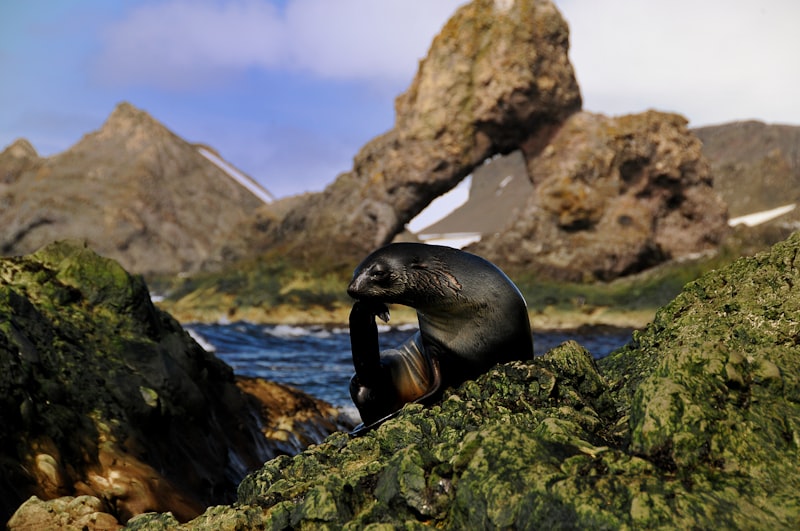Imagine standing at the edge of a vast, echoing canyon. Now, transpose that sensation into the ocean, where instead of echoes, you hear the haunting calls of whales, the clicks of dolphins, and the crackling of snapping shrimp. These sounds are not mere noise; they are vital signals used by marine creatures to navigate, hunt, communicate, and mate in the vast expanse of the sea.
Scientists and researchers in marine bioacoustics study these sounds to decipher their meanings and roles in marine ecosystems. It’s akin to decoding a complex language where every click, whistle, or song serves a purpose. For example, whales use low-frequency calls that can travel for thousands of miles to communicate with others of their kind across ocean basins. These calls carry information about identity, location, and even emotional state, crucial for maintaining social bonds and finding mates.
Moreover, bioacoustics helps monitor the health of marine environments. By tracking changes in natural soundscapes, researchers can assess the impacts of human activities such as shipping, construction, and resource extraction. These activities introduce noise pollution, disrupting the delicate balance of underwater sound communication vital to marine life.
In essence, marine bioacoustics is more than just listening to the ocean; it’s about unlocking the secrets of its inhabitants and preserving their world. By understanding and respecting the acoustic environment of the ocean, we can ensure its conservation and the survival of its mesmerizing symphony for generations to come.
Echoes of the Deep: Unveiling Mysteries Through Marine Bioacoustics
Imagine this underwater world as a grand concert hall, where every creature, from the smallest shrimp to the largest whale, contributes to a cacophony of clicks, chirps, and hums. These sounds, often imperceptible to human ears without specialized equipment, carry vital information about the health of marine ecosystems and the behavior of its inhabitants.

At the heart of marine bioacoustics lies the study of sound propagation in water. Unlike in air, where sound travels relatively straightforwardly, underwater sound waves behave differently due to water’s density and temperature gradients. Scientists use hydrophones, underwater microphones sensitive to these acoustic signals, to eavesdrop on the ocean’s secrets.
One of the most enchanting aspects of marine bioacoustics is its role in understanding marine mammal communication. Whales, known for their haunting songs that traverse vast ocean expanses, use sound not just to communicate but also to navigate and locate prey. These songs, often composed of rhythmic patterns and varying frequencies, are believed to play a crucial role in social interactions and mating rituals.
Beyond marine mammals, bioacoustics sheds light on the entire ecosystem’s health. Coral reefs, bustling underwater cities of biodiversity, emit distinct sounds that reveal their vitality and the impact of environmental changes. By monitoring these acoustic signatures, researchers can assess reef health and track the effects of climate change and human activities on these delicate ecosystems.
Ocean Symphony: The Hidden Language of Marine Bioacoustics
Have you ever wondered about the secrets whispered beneath the waves? Imagine a world where communication happens not through words, but through a symphony of sounds. Welcome to the intriguing realm of marine bioacoustics, where the ocean’s creatures orchestrate a symphony that rivals any terrestrial concert.
In the depths of the ocean, far from human eyes, marine life thrives in a realm dominated by sound. From the haunting calls of whales echoing across vast distances to the intricate clicks of dolphins coordinating their movements, every species contributes to this underwater opera. Each sound serves a purpose – from finding food to attracting mates and navigating the labyrinthine depths.
One of the stars of this symphony is the majestic humpback whale. These giants of the deep produce haunting melodies that travel for thousands of miles, carrying messages of love and warning through the ocean’s expanse. Their songs, complex and evolving, have baffled scientists and inspired artists for decades.
But it’s not just the whales that participate in this acoustic ballet. Dolphins, with their playful clicks and whistles, engage in sophisticated conversations that rival human speech in complexity. These sounds aren’t just noises; they convey detailed information about identity, location, and even emotional state.
Even the smallest creatures contribute to this grand composition. Fish produce a cacophony of pops, grunts, and chirps, each serving as a vital piece of the marine ecosystem’s puzzle. These sounds aren’t just background noise; they are the heartbeat of the ocean itself, pulsing with life and energy.
Studying marine bioacoustics isn’t just about understanding animal communication; it’s about unlocking the secrets of the ocean’s past, present, and future. By deciphering these acoustic codes, scientists can monitor marine populations, study the impact of human activity on underwater environments, and even discover new species.
Listening to Giants: Whale Songs and Marine Bioacoustics
Ever wondered what it’s like to eavesdrop on giants of the deep? Whale songs are not just mysterious melodies; they are windows into the fascinating world of marine bioacoustics. These majestic creatures communicate through intricate sequences of sounds that travel vast distances underwater, echoing through the ocean’s depths.
Whale songs are more than just beautiful; they serve crucial purposes in the lives of these marine behemoths. From attracting mates to coordinating group activities like hunting and migration, these acoustic signals are their language of survival. Imagine a symphony underwater, where each note carries a story of life beneath the waves.
Researchers dive deep into the study of marine bioacoustics to unravel the secrets hidden within these songs. By analyzing the patterns, frequencies, and durations of whale calls, scientists can decipher their meanings and even track populations across oceans. It’s like deciphering a complex code written in the language of the sea.
The impact of human activities on whale songs is profound. As our oceans grow noisier with shipping traffic, underwater drilling, and sonar technology, these sounds face disruption. This interference can confuse whales, affect their migration patterns, and even lead to collisions with ships. It’s a reminder of how delicate the balance is in their underwater world.
Understanding whale songs isn’t just about curiosity; it’s about conservation. By studying these acoustic signals, scientists can advocate for quieter ocean environments and safer habitats for whales. It’s a call to listen more carefully, not just to the giants of the sea, but to the messages they convey about our impact on their world.
Next time you hear about whale songs, remember they’re more than just enchanting sounds. They’re vital clues in the ongoing exploration of marine bioacoustics, revealing the intricate lives of these ocean giants. So, let’s listen closely and ensure we preserve their symphony for generations to come.
Sonic Detectives: How Marine Bioacoustics Reveals Ocean Health
Ever wondered how scientists uncover the mysteries of the deep oceans without diving in? Enter marine bioacoustics, a field where sound becomes the detective. Marine bioacoustics uses underwater sound to explore and understand ocean health, akin to how a stethoscope listens to a heartbeat.
In this sonic world, marine biologists deploy hydrophones, which are underwater microphones, to eavesdrop on the symphony of oceanic life. Each sound, from the haunting calls of whales to the clicks of dolphins, reveals vital information about marine ecosystems. These sounds not only provide insight into species distribution and behavior but also serve as indicators of environmental health.
Imagine a bustling city where honks and chirps indicate activity and health. Similarly, the absence or change in marine sounds can signal disruptions like pollution, climate change impacts, or even the absence of certain species. This auditory detective work helps scientists track changes over time, offering early warnings of ecological shifts.
The applications of marine bioacoustics extend beyond research. Governments and conservation organizations use acoustic monitoring to inform policies for marine protected areas and shipping lanes, aiming to minimize human impacts on underwater habitats.
As technology advances, so does our ability to decipher these acoustic clues. Artificial intelligence now aids in processing vast amounts of acoustic data, uncovering patterns that human ears might miss. This synergy of biology, technology, and environmental stewardship underscores the importance of marine bioacoustics in safeguarding our oceans.
From Sonar to Song: Exploring Marine Bioacoustics Technology
At its core, marine bioacoustics harnesses sound to study marine organisms and their environments. It’s like listening to a symphony where each note tells a unique story. Scientists use hydrophones, specialized microphones for underwater listening, to capture these sounds. These devices pick up everything from the delicate chirps of fish to the haunting calls of dolphins echoing through the waves.
One of the marvels of bioacoustics lies in its ability to track marine life in real-time. Imagine tracking a tagged turtle solely by listening to its movements underwater. This technology doesn’t just observe; it immerses us in the lives of creatures that thrive beneath the ocean’s surface.
Moreover, bioacoustics isn’t just about listening; it’s about interpreting. Scientists analyze sound frequencies and patterns to identify species, study behaviors, and even monitor environmental changes like ocean acidification. It’s akin to deciphering a complex language spoken in the deep blue.
Beyond research, bioacoustics plays a crucial role in conservation efforts. By understanding how human-made noise impacts marine life, researchers can advocate for quieter oceans and safer habitats. It’s a reminder that every sound we make has consequences beneath the waves.
In essence, marine bioacoustics is more than a scientific tool; it’s a gateway to a hidden world. It sparks curiosity, fosters empathy for marine creatures, and underscores the interconnectedness of all life on Earth. As we continue to explore and innovate, the symphony of the seas continues to captivate and inspire us all.
Underwater Soundscapes: Mapping Marine Bioacoustics
In the depths of our oceans, a complex orchestra of sounds plays out, revealing the intricate lives of marine creatures. From the haunting calls of humpback whales to the clicks of dolphins and the crackling of shrimp, each sound carries a story. These bioacoustic signals are not just noise but vital communication channels that animals use for navigation, finding food, and even mating.
Imagine being able to map out these underwater soundscapes, much like exploring a city with its own unique soundscape. Scientists use specialized equipment to record and analyze these acoustic signals, creating detailed maps that highlight the diversity and density of marine life in different oceanic regions. Just as each neighborhood in a city has its own vibe, each oceanic habitat resonates with its unique blend of sounds.
The study of marine bioacoustics isn’t just about understanding the present; it’s also a window into the past and future of our oceans. Changes in these underwater soundscapes can indicate shifts in marine ecosystems, such as the impact of climate change or human activities like shipping and underwater construction.
One might wonder, how do scientists capture these sounds? Picture underwater microphones, known as hydrophones, strategically placed to eavesdrop on the ocean’s conversations. These recordings capture everything from the faintest whispers of shrimp to the thunderous calls of whales, providing a rich tapestry of data for researchers to unravel.
Exploring underwater soundscapes isn’t just about scientific curiosity; it’s about conservation and preservation. By understanding the intricacies of marine bioacoustics, we can better protect vulnerable species and habitats, ensuring that these underwater symphonies continue to play for generations to come.
So, next time you hear about mapping marine bioacoustics, think of it as deciphering the language of the oceans—an awe-inspiring journey into the heart of underwater soundscapes.
The Language of Fish: Understanding Marine Bioacoustics
Imagine being in the ocean depths, surrounded by an orchestra of clicks, pops, and whistles. These sounds aren’t just random noise; they are the conversations of fish. Each species has its own unique set of vocalizations, akin to dialects in human languages. Just like how we recognize accents, scientists can identify different fish species based on their distinct sounds.
The primary function of fish sounds varies widely. Some use sound to attract mates, much like birds singing in the early morning. Male fish, such as the famous croaker fish, produce elaborate calls to court females during breeding seasons. These calls are often rhythmic and can carry over long distances underwater, ensuring they reach potential mates.
Communication isn’t the only purpose of fish sounds. Predatory fish like the toadfish use low-frequency calls to stun or disorient their prey before striking. It’s their way of using sound as a weapon, much like how bats use echolocation to hunt in the darkness.

Navigating through the expansive ocean requires precision, and fish have evolved to use sound as a GPS of sorts. Some species emit sounds that bounce off underwater objects, helping them navigate through murky waters or avoid obstacles. It’s like their own version of sonar, guiding them through a three-dimensional world where vision is limited.
Scientists study these acoustic signals using underwater microphones called hydrophones. These devices capture the symphony of underwater life, revealing intricate details about how fish interact acoustically. Understanding these signals is crucial for conservation efforts and managing marine ecosystems.
Next time you’re by the ocean, take a moment to appreciate the hidden language of fish. Their clicks and chirps tell stories of courtship, survival, and the rhythm of life beneath the waves. It’s a world where sound isn’t just a sensation but a vital means of connection and survival, painting a vivid picture of the intricate ecosystems that thrive beneath the surface.
Frequently Asked Questions
How does human-generated noise impact marine ecosystems?
Learn how human-generated noise affects marine ecosystems, exploring its detrimental impacts on marine life such as disruption of communication, stress to species like whales and dolphins, and interference with essential behaviors like feeding and migration.
What is marine bioacoustics and why is it important?
Marine bioacoustics is the study of sound in the ocean and its biological implications. It explores how marine organisms use sound, how human activities affect marine soundscapes, and helps in conservation efforts by understanding and mitigating anthropogenic noise impacts.
What technologies are used to study marine bioacoustics?
Learn about the technologies used to study marine bioacoustics, including hydrophones, acoustic tags, and passive acoustic monitoring systems. Understand their roles in tracking marine life, assessing ecosystem health, and studying underwater soundscapes.
How do marine animals use sound in their environment?
Learn how marine animals utilize sound to communicate, navigate, and hunt in their underwater environment. Discover the fascinating ways sound plays a crucial role in their survival and interactions.
What are some current research findings in marine bioacoustics?
Explore recent discoveries in marine bioacoustics with our concise overview of current research findings. Discover how marine animals use sound for communication and navigation, and learn about the impact of human-generated noise on marine ecosystems.


